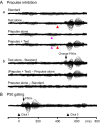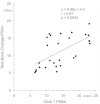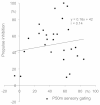Prepulse inhibition of change-related P50m no correlation with P50m gating
- PMID: 24255871
- PMCID: PMC3825222
- DOI: 10.1186/2193-1801-2-588
Prepulse inhibition of change-related P50m no correlation with P50m gating
Abstract
Both prepulse inhibition (PPI) of the startle response and P50 sensory gating are important tools to investigate the inhibitory mechanisms of sensory processing. However, previous studies found no or a weak association between these two measures, which may have been due to the different indexes used. We examined the relationship between P50 sensory gating and P50 PPI. P50m sensory gating and PPI of Change-related P50m were assessed in 14 subjects using magnetoencephalography. Concerning P50m sensory gating, the amplitudes of the response to the second click relative to that to the first one were reduced by 43 and 47% for the left and right hemisphere, respectively. Change-related P50m was evoked by an abrupt sound pressure increase by 10 dB in a continuous click train of 70 dB. When this test stimulus was preceded by a click (prepulse) with a weaker sound pressure increase (5 dB) at a prepulse-test interval of 30, 60, or 90 ms, Change-P50m was suppressed by 33 ~ 65% while the prepulse itself elicited no or very weak P50m responses. Although the amplitude of the P50m response to the first click and the amplitude of the Change-P50m test alone response were positively correlated (r = 0.6), the degree of the inhibition of the two measures was not (r = -0.06 ~ 0.14). The neural origin was estimated to be located in the supratemporal plane around the superior temporal gyrus or Heschl's gyrus and did not differ between P50m and Change-P50m. The present results suggest that P50m and Change-P50m are generated by a similar group of neurons in the auditory cortex, while the mechanisms of P50m sensory gating and Change-P50m PPI are different.
Keywords: Auditory evoked magnetic fields; Prepulse inhibition; Sensory gating.
Figures





References
LinkOut - more resources
Full Text Sources
Other Literature Sources
Research Materials
Miscellaneous

